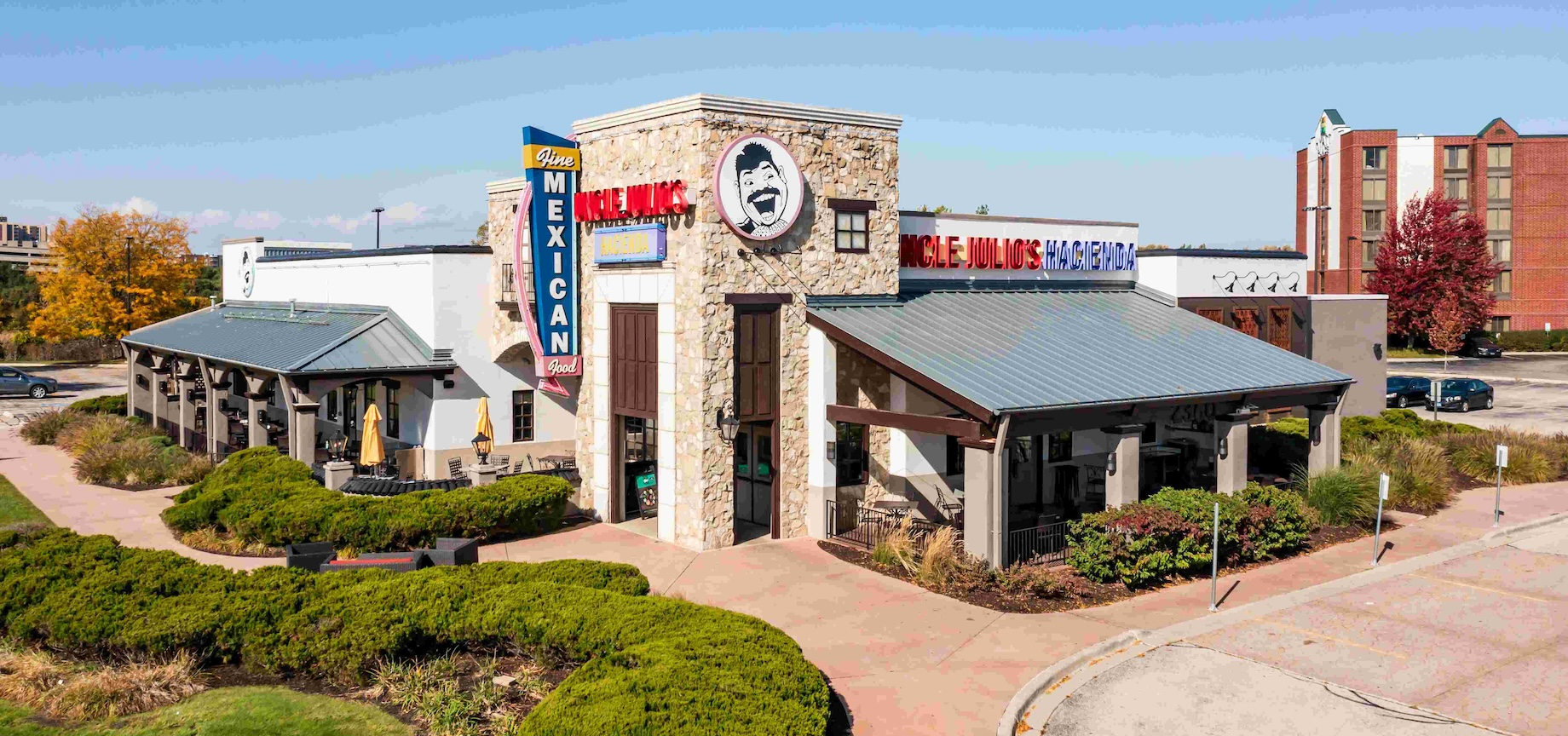1031 exchange market participants hope less volatility in interest rates and a narrowing bid-ask gap could spur more activity in the coming year. According to The Boulder Group, 1031 exchange activity hit a 12-year low in 2024 as higher interest rates continued to impact transaction volume and diminish the need for the tax-deferred investment strategy. “Activity is expected to pick up as the year progresses, although levels will remain far off the peak velocity in 2021,” noted The Boulder Group president Randy Blankstein.

The Boulder Group recently represented the developer in the sale of a single-tenant Uncle Julio’s restaurant located in Lombard, Illinois. The property was purchased by a 1031 exchange buyer for $4.2 million. Photo courtesy of The Boulder Group
The 1031 exchange market follows the general ebb and flow in the transaction market, so it’s not surprising that 1031 exchange activity dropped sharply alongside a decline in the broader sale market. Commercial real estate transaction momentum turned positive again last year with $323.1 billion in single-asset sales, but volume remains well below the more than $600 billion in 2021, according to MSCI Real Assets.
Although the market is less confident about rate cuts in the coming year, more stability in the rate environment could help both sellers and buyers move off the sidelines. “There's definitely some rate uncertainty, but there’s been more transaction activity, which really helps create some pricing certainty that helps buyers and sellers come closer to an agreement on value,” said First American Exchange Co. president Julie Baird.
What Could Motivate Sellers
Demographic shifts continue to serve as a tailwind behind 1031 exchange activity. Aging Baby Boomers are selling out of management-intensive assets like apartments and trading into more-passive income-producing investments. “That trend has continued and will continue,” said Matthew Mousavi, co-head of SRS Real Estate Partners’ national net lease team. He added: “With a lot of these groups, they’re not just seeking passive assets; they also want to go where the growth is.” The Sunbelt remains a hot spot for 1031 buyers, and states like Texas and Florida are especially active due to their favorable tax structures.

SRS Real Estate Partners recently represented the seller of a long-term ground lease for a Home Depot in Dothan, Alabama. The East Coast-based 1031 exchange buyer paid $7.68 million. Photo courtesy of SRS Real Estate Partners
Another factor that could fuel 1031 activity over the next few years is the volume of loan maturities. According to the Mortgage Bankers Association, nearly 20% of the $4.8 trillion of outstanding commercial mortgages held by lenders and investors, or $957 billion, will mature in 2025. Estimates from S&P Global put the level of loan maturities over the next three years at $3.4 trillion, with annual maturities peaking in 2027 at $1.25 trillion.
“We anticipate that maturities are going to add to overall transaction volume because some sellers are going to be in a position where they can’t continue to refinance,” said Baird. However, even though investors may be selling at decreased values, they may still have a capital gain from the sale that can be deferred through a 1031 exchange.
Consider the example of an owner that bought a shopping center for $70 million and later, when the property value had appreciated to $100 million, refinanced the property for $80 million. However, once the debt is maturing, the owner sells at $75 million rather than refinance at a higher interest rate. Even though the value has dropped, the seller still has a $5 million gain from the original acquisition price. “If they dispose of that asset, and they don’t do an exchange, they’re going to have a tax implication on not only that gain but depreciation recapture, too,” said Baird. “So we’re trying to make sure investors are aware that even though, on paper, it may look like they’re selling for a loss, they may still actually have gains where they need to think about deferral strategies.”
Reverse Exchanges and Seller Financing
Reverse exchange activity has risen over the past 18 months. Often, an owner lists a property for sale or gets it under contract and then looks for a replacement property. For a reverse exchange, the property owner starts by finding a property or properties to purchase. “They can go out and secure that asset using a reverse exchange and get exactly what they want, and then they can sell their disposition asset,” said Baird.
The rules governing 1031 exchanges give an investor 45 days to identify what property or properties it plans to buy and then 180 days to close. A reverse exchange allows an investor to be more proactive in finding a replacement property and relieve the timing pressure associated with completing an exchange.
In a reverse exchange, a Qualified Intermediary like Baird’s First American Exchange Co. creates an LLC and buys and holds the property on the investor’s behalf. Then, the investor has 45 days to identify what property to sell and 180 days to get it sold. The reverse exchange tends to give an investor more control because the investor can decrease the price to expedite a sale, noted Baird.
Demand for seller financing also has increased. When a seller provides financing and still wants to do a 1031 exchange with the proceeds, some specific considerations have to be processed to execute the exchange. Generally, the seller financing being done is similar to a short-term bridge loan, with buyers anticipating that rates will move lower and allow them to refinance.
1031 Investors Target Net Lease Assets
A rise in 1031 exchange activity would be welcome news for the single-tenant net lease investment market. 1031 exchange buyers are the lifeblood of the net lease investment market. Historically, between 40 and 50% of buyers in the net lease market are looking for replacement properties to complete tax-deferred exchanges, according to Bryn Feller, a Northmarq managing director specializing in net lease investments.
Exchange investors are attracted to net lease assets for a variety of reasons, including the passive lease structure and the steady income they generate. Net lease also works well with the tight timeline required to complete an exchange. “More than any other asset class, net lease can be bought more quickly and understood more quickly, and there’s more inventory to select from,” said Feller.
Exchange investors currently identifying replacement properties are finding plenty of options in the net lease market. According to Feller, the inventory of retail net lease assets, in particular, is at its highest level, with an estimated $28 billion in for-sale inventory. However, the available inventory is definitely a mixed bag. Feller describes the current for-sale inventory as falling into three categories: completely undesirable assets, interesting but not compelling assets and assets that everyone wants, such as quick-service restaurants, big-box retail and medical office.
Net lease cap rates have risen for the past 11 quarters due to a backlog of assets on the market. However, fourth-quarter data indicates some stabilization in pricing, with buyer and seller expectations moving closer together. According to The Boulder Group, the spread between asking and closed cap rates for net lease properties remained flat or decreased for net lease properties in the fourth quarter. On average, the firm reported that single-tenant cap rates for retail increased slightly in the fourth quarter to 6.52%.
Northmarq anticipates that 1031 transactional activity will move from roughly 20% of net lease investment sales currently to 30 to 35% over the next 36 months, fueled in part by aging Baby Boomers that are estate planning or transitioning into retirement. “When those assets start trading once again, much of that capital will find its home within the net lease industry,” said Feller.
National Asking Cap Rates
| Q3 2024 | Q4 2024 | Basis-Point Change | |
| Retail | 6.5% | 6.52% | +2 |
| Office | 7.75% | 7.78% | +3 |
| Industrial | 7.15% | 7.23% | +8 |
| Overall | 6.73% | 6.76% | +3 |
Source: The Boulder Group Net Lease Market Report | Q4 2024
By Beth Mattson-Teig
Contributor, Commerce + Communities Today